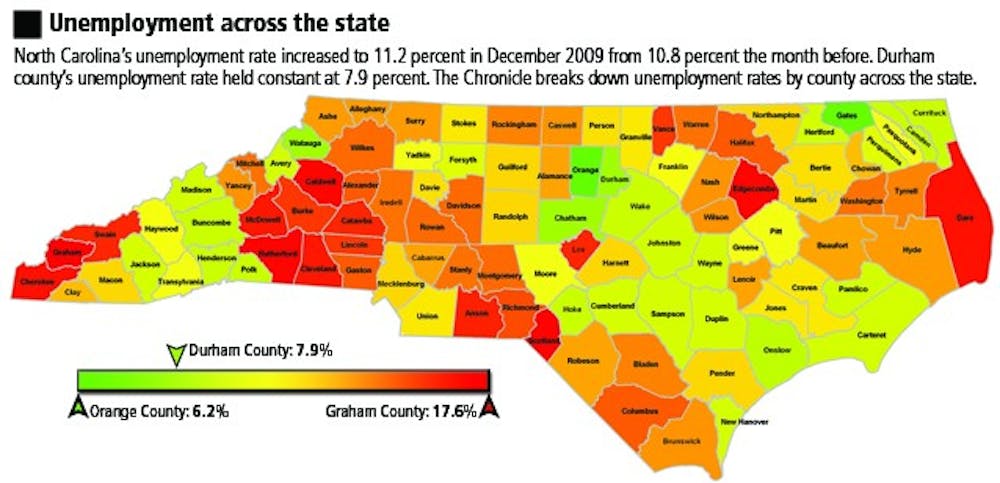Don’t expect pre-recession unemployment numbers to return to North Carolina any time soon.
But compared to the state’s seasonally adjusted unemployment rate, which increased to 11.2 percent in December from 10.8 percent the month before, Durham County has one of the lowest unemployment rates in the state due to the area’s business diversity, said Larry Parker, a spokesperson for the North Carolina Employment Security Commission.
According to the N.C. ESC statistics, Durham County’s unadjusted unemployment rate for December was 7.9 percent, an increase from 6.1 percent the year before, but unchanged from November’s rate.
“Right now, even in the areas that have weathered the storm, like Durham and Orange counties, we’re still seeing job loss in the area,” Parker said.
Since the recession began, the Triangle has lost about 3 percent of its jobs, compared to the national decline of about 7 percent, said Michael Walden, W. M. Neal Reynolds distinguished professor of economics at North Carolina State University.
“We have an economy in the Triangle that is based on high skill levels,” Walden said. “We have the greatest number of Ph.D.s per capita of any other metropolitan area with more than half a million.... Typically, people with more education tend to suffer less during recessions.”
Job sectors with the highest unemployment rates include construction and manufacturing, which lost 3,700 jobs in 2009, while education and health services has seen one of the biggest gains in employment over the year, with an increase of 1,000 jobs, said Pam Davenport, ESC labor market information officer.
Durham area employers anticipate hiring at a moderate pace during the first quarter of 2010, according to a news release on the results of the Manpower, Inc. Employment Outlook Survey. Twelve percent of the 28,000 U.S. employers surveyed said they plan to hire more employees, 11 percent expect to reduce their payrolls and 74 percent expect to maintain their current staff levels, according to the December 2009 release.
“In 2008, the job loss kind of exploded and was really happening in a lot of job sectors, and now it’s kind of just slowed down, but we’re still seeing it a little bit,” Parker said.
Walden predicts that this year there will be some modest improvement, with professional jobs seeing the biggest decline in unemployment. Professional workers tend to contribute more to the economy, making their jobs more valuable.
He added that he expects job growth in all sectors to begin returning within two or three months, but that it will be very slow.
“We went into the recession with an unemployment rate of about 4.5 percent,” Walden said. “I think it will be years, possibly as long as five years, before we see unemployment get that low again.”
The city of Durham is working closely with businesses in the community to encourage them to utilize recruiting and placement services like the Durham JobLink, Kevin Dick, executive director of the Durham Workforce Development Board, wrote in an e-mail.
Despite Durham’s efforts to ease job woes, cities’ resources are limited, Walden said.
“Unfortunately, there’s not a lot that an individual city can do,” he said. “I think the most cost-effective thing cities or counties can do is to look at their sets of regulations regarding new businesses and try to streamline them, do everything they can to make it easier for businesses to start or expand.”
The Career Center has also been working with new employers in the area to diversify the kinds of opportunities available for students, said William Wright-Swadel, Fannie Mitchell executive director of career services.
“I think North Carolina, over the years, is in the top five areas for Duke students to go, so it’s not a small number, but it is also often something that students come to late in their search,” Wright-Swadel said. “There’s certainly no indication at this point that the number of students staying in North Carolina will go down.”
He added that many students initially look to areas outside of the state for job opportunities but end up finding jobs in the Raleigh-Durham area, and some students get jobs in the area for one or two years before going to graduate school.
Compared to previous years when large employers hired several people at once, now smaller employers are hiring fewer students at a time.
Wright-Swadel said the Career Center is running a new “just-in-time” career fair in April for students still looking for jobs and for employers, particularly local ones, who could not anticipate their employment needs in time for on-campus recruiting programs.
Get The Chronicle straight to your inbox
Sign up for our weekly newsletter. Cancel at any time.
He noted that Duke has followed the national pattern of an increase in the number of students going to graduate school after graduation. Last year, about 30 percent of seniors went to graduate school, while in a good economy, the number would typically be near 27 percent. He does not think the number will increase this year compared to last year.
“[Students] know the competition is steeper than it was a couple of years ago,” Wright-Swadel said. “Looking for a first job always produces anxiety, but in a difficult market, students are even more anxious.”

